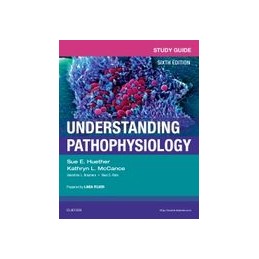- Obniżka


 Dostawa
Dostawa
Wybierz Paczkomat Inpost, Orlen Paczkę, DHL, DPD, Pocztę, email (dla ebooków). Kliknij po więcej
 Płatność
Płatność
Zapłać szybkim przelewem, kartą płatniczą lub za pobraniem. Kliknij po więcej szczegółów
 Zwroty
Zwroty
Jeżeli jesteś konsumentem możesz zwrócić towar w ciągu 14 dni*. Kliknij po więcej szczegółów
Get the review and application tools you need to master difficult pathophysiology concepts! Designed to be used with the Understanding Pathophysiology, 6th Edition textbook, this extensively revised study guide utilizes a wide variety of engaging chapter activities, including application-based case scenarios and thousands of interactive questions, to help you easily integrate and apply pathophysiology information to clinical practice. New features of this study guide edition include nearly 30 new case scenarios, Teach These People About Pathophysiology questions, active headings, and more images from the main text. As with previous editions, answers to all questions can be found in the back of the study guide.
Opis
Frontmatter Introduction to Pathophysiology
PART ONE: BASIC CONCEPTS OF PATHOPHYSIOLOGY
Unit 1: The Cell 1. Cellular Biology 2. Genes and Genetic Diseases 3. Epigenetics and Disease (NEW) 4. Altered Cellular and Tissue Biology 5. Fluids and Electrolytes, Acids and Bases
Unit 2: Mechanisms of Self-Defense 6. Innate Immunity: Inflammation and Wound Healing 7. Adaptive Immunity 8. Infection and Defects in Mechanisms of Defense 9. Stress and Disease
Unit 3: Cellular Proliferation: Cancer 10. Biology of Cancer 11. Cancer Epidemiology 12. Cancer in Children and Adolescents
PART TWO: BODY SYSTEMS AND DISEASES
Unit 4: The Neurologic System 13. Structure and Function of the Neurologic System 14. Pain, Temperature, Sleep, and Sensory Function 15. Alterations in Cognitive Systems, Cerebral Hemodynamics and Motor Function 16. Disorders of the Central and Peripheral Nervous Systems and Neuromuscular Junction 17. Alterations of Neurologic Function in Children
Unit 5: The Endocrine System 18. Mechanisms of Hormonal Regulation 19. Alterations of Hormonal Regulation
Unit 6: The Hematologic System 20. Structure and Function of the Hematologic System 21. Alterations in Hematologic Function 22. Alterations of Hematologic Function in Children
Unit 7: The Cardiovascular and Lymphatic Systems 23. Structure and Function of the Cardiovascular and Lymphatic Systems 24. Alterations of Cardiovascular Function 25. Alterations of Cardiovascular Function in Children
Unit 8: The Pulmonary System 26. Structure and Function of the Pulmonary System 27. Alterations of Pulmonary Function 28. Alterations of Pulmonary Function in Children
Unit 9: The Renal and Urologic Systems 29. Structure and Function of the Renal and Urologic Systems 30. Alterations of Renal and Urinary Tract Function 31. Alterations of Renal and Urinary Tract Function in Children
Unit 10: The Reproductive Systems 32. Structure and Function of the Reproductive Systems 33. Alterations of the Female Reproductive System 34. Alterations of the Male Reproductive System
Unit 11: The Digestive System 35. Structure and Function of the Digestive System 36. Alterations of Digestive Function 37. Alterations in Digestive Function in Children
Unit 12: The Musculoskeletal and Integumentary Systems 38. Structure and Function of the Musculoskeletal System 39. Alterations of Musculoskeletal Function 40. Alterations of Musculoskeletal Function in Children 41. Structure, Function, and Disorders of the Integument 42. Alterations of the Integument in Children
Answer Key
